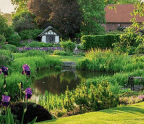Eyes to the Front

Why do so many English houses, from Victorian villas to Betjemanesque suburban dwellings and post-war council estates, have front gardens? The answer is not difficult: they were designed to protect privacy, enhance dignity, provide a sense of spaciousness, and keep the town-dweller in touch with the sense of a rural idyll that underlies so much of the English approach to town living. So what do we see today? Car parks, dustbin enclosures, and brutal stretches of tarmac and concrete.

A recent study carried out by the Royal Horticultural Society and the Universities of Sheffield, Westminster and Virginia urges the rediscovery of value in our front gardens: properly treated, they can contribute to happiness and relaxation, not only in terms of our mood, but actually having an effect on cortisol levels.
“They are the forgotten spaces but) of BBC Two’s who, during lockdown last year, created a wild garden at the front of his new home in South London. “They can improve our view and enjoyment from inside the house as well as from the street, and they can enable us to engage with our community and be places for learning about and sharing in nature. They can act also as wildlife corridors between houses and contribute to the greening of our towns and cities.”
You’re reading a preview, subscribe to read more.
Start your free 30 days





